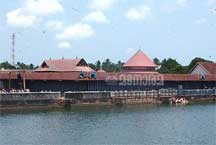|
| |
Koodalmanikyam Temple

Koodalmanikyam Temple is an ancient Hindu temple in Irinjalakuda, a
small town in Trissur district, Kerala, India. This one of the most well known
temples in Kerala built before the 15th Century. The lord at Koodalmanikyam is
Chathurbahu Vishnu with Conch, Chakra, Gada and Japamaala. The general belief,
however, is that the Lord is Bharatha the brother of Sree Rama.
A distinctive feature of
Koodalmanikyam temple is that there is only one single Prathista. Even
Vigneswara, usually found in all temples dose not find place here. Usually when
Thulasi leaves are offered to the diety, its seeds invariably sprouts in the
premises. How this has not at any time happened in this temple is a mystery.
One explanation is that Thulasi plant being sacred; it is worshipped wherever it
is found. Probably it is to forbid even such an object of secondary worship in
the temple precincts that Thulasi is not allowed to grow by some unforeseen
power.
The Lord is also known as
Sangameswara. There is a folklore relating to the name Samgameswara. One
saintly person belonging to Taliparambu was on a strange mission. His
objective was to collect the chaithanya of idols of important temples in Kerala
for being transferred to the idol of the temple in his village. This he did
by entering the Sanctum Sanctorum of the temples he visited and transferring the
Chaithanya on to the conch in his possession. When he did the same in
Irinjalakuda he accidentally fell down and the conch was broken instantly
transferring the divinity of all idols he had acquired
on to the idol at Irinjlakuda. Thus the idol in which merged the divine
Chaithanya of several idols came to be known as Sangameswara.
There are beautiful mythologies regarding the origin of the name “Koodal
Manikyam” one of them goes like this. The idol of this temple radiated
magnificent light that excelled manikyam (a mythological precious stone believed
to be kept and protected by divine serpents).
A manikyam kept in the palace of Kayamkulam palace was brought to this temple to
compare with the idol and to see which emits more light! This was brought on the
fron the king of Kayamkulam on promise to return after comparison. When the
Manikyam was brought near the idol it got merged with the idol! (koodal manikyam
means merger of manikyam).and thus the name.
Curiosity turned out to be a nightmare as the manikyam vanished. The whole
temple had to be handed over to the king of Kayamkulam as compensation. Due to
the administrative difficulty the king of Kayamkulam handed over the right of
the temple administration to one Thatchudaya Kaimal it was his family which
handled the temple till 1971.
In Koodalmanikyam there are only three Poojas and no Siveli. The diety is taken
out for ceremonial procession only during the Annual Festival. There is no
Deeparadhana. The floral offerings to the diety consist of Lotus, Tulasi and
Chethi. No other flower is taken for Pooja or for making garlands.
The deity of Koodalmanikyam is considered as the incarnation of “Dhanvanthari
moorthi” The saint of healing. Hence many people approach this temple expecting
cure of their ailments.
Long ago one aged devotee was sitting in Bhajanam at the Temple. He was a victim
of chronic stomachache. One night he had a dream in which the Lord appeared
before him and advised him to pluck out 101 brinjals from his garden and offer
the same as Nivedya. This was done and he was totally relieved of stomachache.
From that day onwards Brinjal Nivedyam became a special Nivedyam at the Temple.
Chembai Vaidyanatha Bhagavatar having heard the curative effect of Brinjal
Nivedya visited the temple in 1972 and made an offering of Brinjal Nivedhya.
Since then he was relieved of a stomach pain he was suffering for quiet a long
period.
The Annual Festival of the Temple held for 11 days in April-May is a well-known
popular event in central Kerala. The festival starts one day after the famous
Thrissur Pooram
Courtesy:
http://keralaarticles.blogspot.com/ and temple information
| |
|



